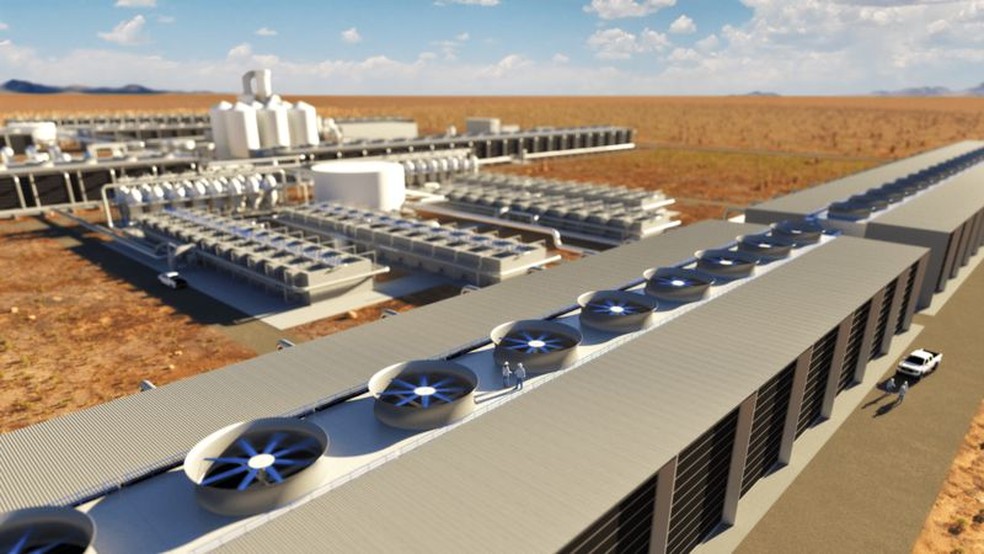The trillion-dollar plan to capture CO2 from the air and cool the Earth
To do this, a gigantic new global industry would be needed – but how would it work? That answer may be key to avoiding a tragic future because of climate change.
The year is 2050. Exit the Permian Basin Petroleum Museum in the US state of Texas and head north through the sun-streaked vegetation, where a few remaining oil pumps make up the landscape, and you will come across a sparkling palace.
The land here is mirrored: the silver-blue waves of an immense solar panel extend in all directions.
In the distance, they bump into a colossal gray wall five stories high and almost a kilometer long. Behind this wall, you can see the pipes and gantries of a chemical factory.
As you approach, you see that the wall is moving – it is made up entirely of huge fans that rotate in steel boxes. It looks like a gigantic air-conditioning unit, blowing in unbelievable proportions.
In a way, that is exactly it. You are looking at a direct air capture plant (DAC), one of tens of thousands of its kind worldwide. Together, they are trying to cool the planet by sucking carbon dioxide from the air.
This Texas landscape was made famous by the billions of barrels of oil extracted from its depths during the 20th century. Now, the legacy of these fossil fuels – the CO2 in our air – is being pumped back into empty reservoirs.
If the world wants to meet the Paris Agreement’s goals of limiting global warming to 1.5 ° C by 2100, landscapes like this may be needed in the middle of the century.
But let’s go back for a moment until 2021, to Squamish, in the Canadian province of British Columbia, where, in contrast to a bucolic horizon of snowy mountains, the finishing touches are being done on a barn-sized device covered with blue canvas.
When it goes into operation in September, the prototype of Carbon Engineering’s direct air capture plant will begin removing 1 ton of CO2 from the air every year.
It is a small start, and a slightly larger plant in Texas is underway, but this is the typical dimension of a DAC plant today.
“Climate change is being caused by excess CO2,” says Steve Oldham, chief executive of Carbon Engineering. “With DAC, you can remove any emission, anywhere, anytime. It is a very powerful tool.”
Most of the carbon capture is concentrated on cleaning emissions at the source: purifiers and filters in chimneys that prevent harmful gases from reaching the atmosphere.
But this is impractical for small and numerous point sources, such as the approximately 1 billion cars on the planet. Nor can it fight the CO2 that is already in the air. That’s where direct capture comes in.
If the world wants to prevent catastrophic climate change, migrating to a carbon neutral society is not enough.
The Intergovernmental Panel on Climate Change (IPCC) warned that limiting global warming to 1.5 ° C by 2100 will require technologies like DAC for “large-scale deployment of carbon dioxide removal measures” – wide scale, in this case, are several billion tonnes each year.
Entrepreneur Elon Musk recently pledged $ 100 million to develop carbon capture technologies, while companies like Microsoft, United Airlines and ExxonMobil are making billion-dollar investments in this area.
“Current models suggest that we will need to remove 10 billion tonnes, or gigatonnes, of CO2 per year by 2050, and by the end of the century, that number needs to double,” says Jane Zelikova, a climate scientist at the University of Wyoming, in the United States. United.
At the moment, “we are practically not removing anything”. “We need to start from scratch”.
The Carbon Engineering plant in Squamish was designed as a test platform for different technologies. But the company has a project for a much larger plant in the oil fields of western Texas, which would capture 1 million tons of CO2 a year.
“Once you’re done, it’s like a shape, you just build replicas of that plant,” says Oldham.
He admits, however, that the volume of work ahead is staggering. “We need to extract 800 gigatonnes from the atmosphere. This is not going to happen overnight.”
The science of direct air capture is simple. There are several ways to do this, but the Carbon Engineering system uses fans to draw air containing 0.04% CO2 (today’s atmospheric levels) through a filter soaked in potassium hydroxide solution – a chemical known as caustic potash , used in the manufacture of soap and various other products.





